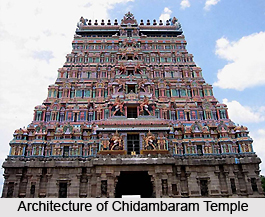 The architecture of Chidmbaram Temple is of special worth. It represents the assimilation of several styles of architecture. Chit Sabha is the innermost portion of the temple, the sanctum sanctorum. This is the place where Lord Shiva performed his cosmic dance. The Lord is represented here with his left leg raised up in a dance pose. The Chit Sabha is the holiest shrine of the temple. It is a wooden structure which has been supported with wooden pillars. It has a hut shaped roof and houses the images of Nataraja and Sivakami.
The architecture of Chidmbaram Temple is of special worth. It represents the assimilation of several styles of architecture. Chit Sabha is the innermost portion of the temple, the sanctum sanctorum. This is the place where Lord Shiva performed his cosmic dance. The Lord is represented here with his left leg raised up in a dance pose. The Chit Sabha is the holiest shrine of the temple. It is a wooden structure which has been supported with wooden pillars. It has a hut shaped roof and houses the images of Nataraja and Sivakami.
By the side of the Lord at Chidambaram, to the left, is the sanctum of Goddess Sivakama Sundari. To the right is the Chidambara Rahasyam wherein there is no image or Lingam. A Tiruvasi, the circular arch or Prabha with a Vel, is in front. The Prabha is marked by a string of golden Vilva leaves hung over it. Here Lord Siva is worshipped as Akasa which pervades the whole world. The stone steps leading to the Chit Sabha at Chidambaram are five in number and are plated with silver. They are said to represent the five mystic letters of the Panchakshara Mantra, NA, MA, SI, VA, YA. The door-posts are all silver-plated and bear an embossed representation of Vyaghrapada and Patanjali figuring as Dwarapalakas.
The roof of the temple is gold-plated. Hence it is called Ponnambalam. The conception of the idol of Nataraja, which has been claimed in the civilised world as the greatest work of Oriental art, is not merely a stroke of the imagination of an artist, but is a monument of the inner vision of the artist devotee, who could conceive the image of Lord Shiva as He revealed Himself to him. Modern scientists accept that each atom is nothing but a microscopic indivisible particle of God in perpetual motion in a circle. If there is such a motion there must be a Mover. If the Mover is immanent He must be in motion too. With this conception in mind the artist must have prayed for ages for getting the Divine revelation to put it into a concrete shape. In the figure of Nataraja both Mover and the moved are depicted in lifelike shape. This is the climax of revelation and that is Nataraja at Chidambaram. Science is personified in Act in the form of Nataraja.
In the second prakaram of the Chidambaram Temple is the Nritt Sabha or the hall of dance. The hall houses the image of Lord Shiva in the Urdhatandava pose winning over Kali in a dance duel. The Nritt Sabha is in the form of a chariot drawn by horses. The house of Gods known as the Dev Sabha is also in the second prakaram. It houses festival images of the Pancha Murtis (Somaskandar, Parvati, Vinayaka, Subramanya and Chandikeswara) and other deities. Mulanathar or the representation of Shiva as a Lingam is also placed in the second prakaram.
The most magnificent structures in the temple are the four lofty gopurams or towers in the four cardinal directions, piercing the walls of the outermost prakaram. Each of the gopuram is a massive structure. They are 250 feet in height and have seven tiers. The Western tower is the oldest one. The towers, on either side of the gateways represent 108 postures of the classical Bharatnatyam tradition. The towers are filled with images from Hindu mythology. From the second tier onward, on each of the gopuram, are found images of various representations of Shiva such as Bhikshatana, Kankala Kalyanasundarar, Somaskandar etc.
The temple architecture of Chidambaram Temple has a lot of philosophical meanings associated with it. Therefore it can be said that the temple was constructed not just for the sake of artistry but if properly understood it gives important lessons of life.





















